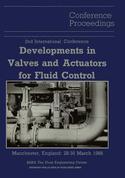Proceedings of the 2nd International Conference on Developments in Valves and Actuators for Fluid Control, 1988 Manchester, England: 28–30 March 1988
Langue : Anglais
Coordonnateurs : Wood Peter, Grove Lorraine

The flow of two-phase mixtures through restrictions. is a complex phenomenon that to date has not been fully described analytically. It is an area that received a geat deal of attention because of its application to nuclear reactor technology. The majority of the work done in this area considered ideal geometries such as nozzles, orifices and straight pipes. In the area of control valves very little work has been done. Brockett & King [1] studied subcooled water. Stiles [2] looked at subcooled freon. Martinec [4] compared subcooled freon in valves with ideal geometries. Sheldon & Schuder [3) looked experimentally at airjwater mixtures through valves that resulted in a sizing procedure. Fagerlund [10] presented an analytical model that required use of the Sheldon & Schuder data to establish the behavior of valves as opposed to more ideal geometries. However, the data used was limited to a single valve travel. Fagerlund & Storer [11] have expanded this to include several valve travels that further generalizes the technique. It is the intent of this paper to summarize a practical approach to s1z1ng valves for two-phase service that may be reduced to either a graphical or calculator procedure. Discussion of Analysis A fundamental assumption in this method is that the quality remains constant between the inlet and the vena contracta. For gas-liquid flows it is obvious providing vaporization does not occur.
A1 A variable orifice rotary control valve.- A2 Bellows seals for rotary (1/4 turn) valves.- A3 Contiguous sealing of metal seated butterfly valves.- B1 Testing of valves and actuators in fire environments.- B2 Cold water leak detection in high pressure stainless steel isolation valves using ultrasonic noise emission.- C1 Electronic actuator design.- C2 New trends in pneumatic actuator designs.- D1 Plug vibrational tendencies of top guided throttling control valves.- D2 A one dimensional quasi-steady model for prediction of safety valve lift characteristics.- D3 Use of damping devices to control the stability of spring loaded safety valves operated in liquid service.- E1 The development and applications of duplex stainless steel for control valve equipment.- E2 New and improved high nickel alloy castings.- E3 Development in soft seated trims for control valves.- E4 Engineering thermoplastics in actuator construction.- F1 Sizing of low pressure air valves for safe filling and draining of pipelines.- F2 Control valve sizing for non-ideal fluids.- G1 Experimental investigations to determine flow rate capacities and noise emission during cavitation and flashing in control valves.- G2 Universal method for quantifying the severity of a cavitating service.- H1 Tests of check valves at EDF development of a dampened check valve.- H2 Check valve closure behaviour; experimental investigation and simulation in waterhammer computer programs.- H3 Innovations in non-intrusive testing and trending of motor operated valves and check valves.- J1 Qualification of French pressurized water nuclear power stations valves.- J2 Lubrication and wear of valve headgear — a case study.
Date de parution : 04-2014
Ouvrage de 361 p.
21x29.7 cm
Thèmes de Proceedings of the 2nd International Conference on... :
Mots-clés :
Monitoring; Trend; actuator; control; innovation; metal; motor; pressure; simulation; stability; temperature; water
© 2024 LAVOISIER S.A.S.
